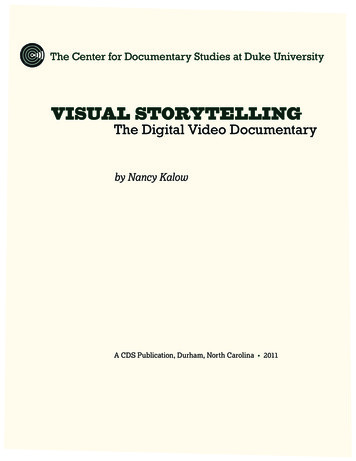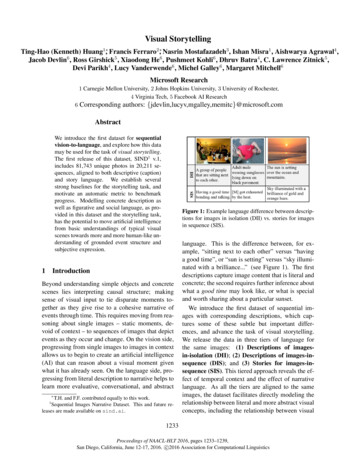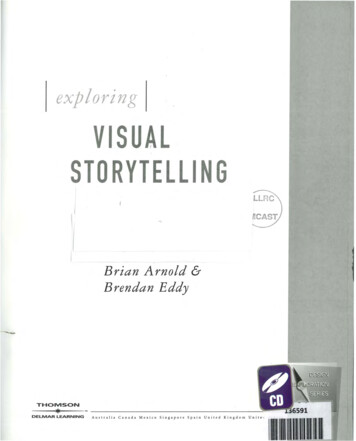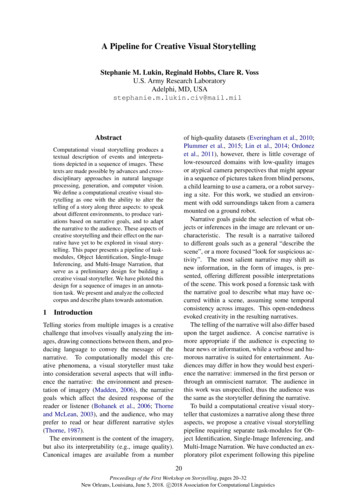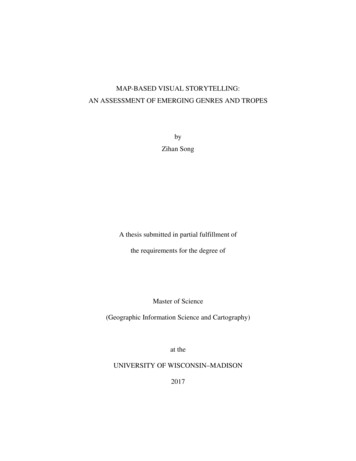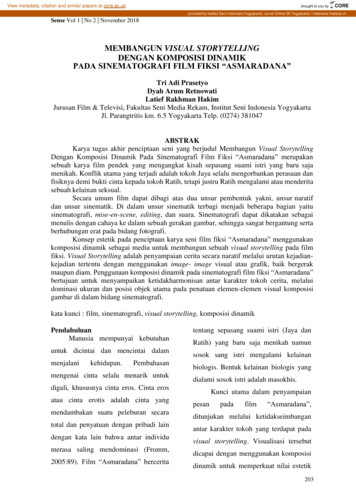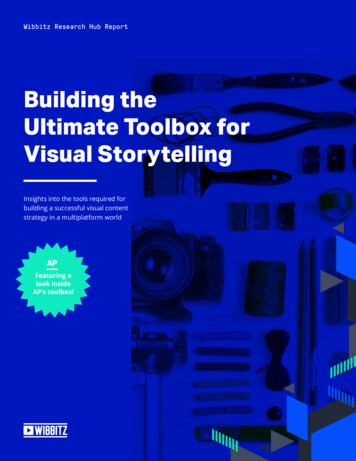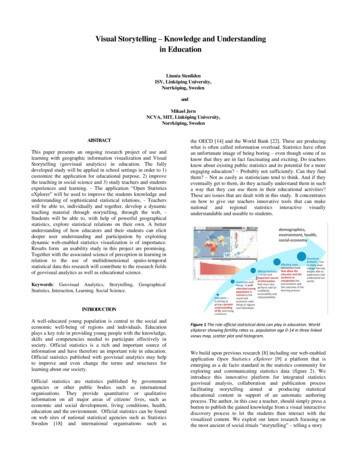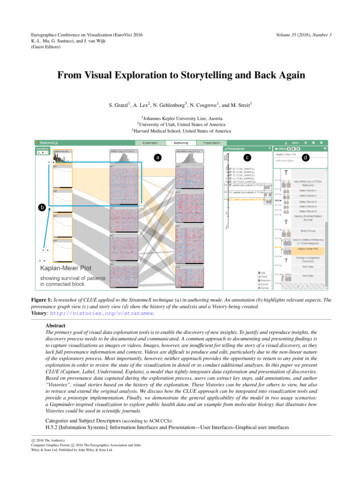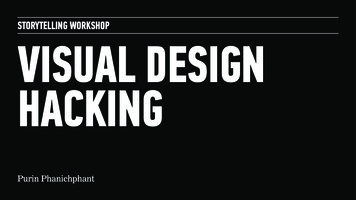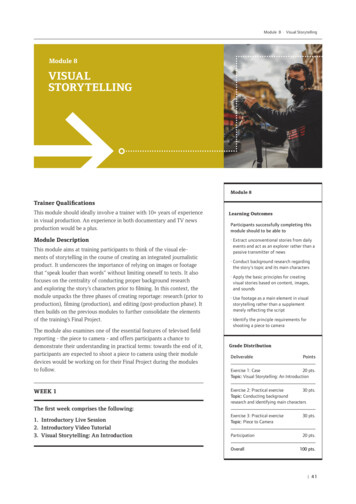
Transcription
Module 8 · Visual StorytellingModule 8VISUALSTORYTELLINGModule 8Trainer QualificationsThis module should ideally involve a trainer with 10 years of experiencein visual production. An experience in both documentary and TV newsproduction would be a plus.Module DescriptionThis module aims at training participants to think of the visual elements of storytelling in the course of creating an integrated journalisticproduct. It underscores the importance of relying on images or footagethat “speak louder than words” without limiting oneself to texts. It alsofocuses on the centrality of conducting proper background researchand exploring the story’s characters prior to filming. In this context, themodule unpacks the three phases of creating reportage: research (prior toproduction), filming (production), and editing (post-production phase). Itthen builds on the previous modules to further consolidate the elementsof the training’s Final Project.The module also examines one of the essential features of televised fieldreporting - the piece to camera - and offers participants a chance todemonstrate their understanding in practical terms: towards the end of it,participants are expected to shoot a piece to camera using their moduledevices would be working on for their Final Project during the modulesto follow.WEEK 1Learning OutcomesParticipants successfully completing thismodule should to be able to· E xtract unconventional stories from dailyevents and act as an explorer rather than apassive transmitter of news· Conduct background research regardingthe story’s topic and its main characters· Apply the basic principles for creatingvisual stories based on content, images,and sounds· Use footage as a main element in visualstorytelling rather than a supplementmerely reflecting the script· Identify the principle requirements forshooting a piece to cameraGrade DistributionDeliverablePointsExercise 1: Case20 pts.Topic: Visual Storytelling: An IntroductionExercise 2: Practical exercise30 pts.Topic: Conducting backgroundresearch and identifying main charactersThe first week comprises the following:1. Introductory Live Session2. Introductory Video Tutorial3. Visual Storytelling: An IntroductionExercise 3: Practical exerciseTopic: Piece to Camera30 pts.Participation20 pts.Overall100 pts. 41
Module 8 · Visual StorytellingIntroductory Live SessionContrary to previous ones, this module can begin with a live sessionfamiliarizing participants with the material through a video reportagefollowed by discussion. The trainer can first get introduced to the traineesbefore offering an overview of the module’s topics and requirements (25minutes). S/he can then play a video (10 minutes) to be followed by aconversation addressing the following questions (40 minutes): What are the video’s main messages? How were these messages conveyed through the visual and soundeffects? What were the most striking visual elements in the video? Why? What impressions did the video leave? What are the main strengths and weaknesses in the video?Duration: 75 min.Video Tutorial 1The module’s introductory tutorial addresses three features (information,identification, and fascination) and four constituting elements (images, content/voiceover, soundbites, and cleansound) that a video reportage entails.Lesson 1Visual Storytelling: An IntroductionThe first week’s lesson introduces the elements of a narrative and themeans to construct one based on in-depth research during the pre-production phase. In the process of doing so, it briefly unpacks the constituting elements of a visual report (content, image, and sound).Exercise 1: Visual Storytelling - An IntroductionIn this exercise, participants are offered two videos to watch followed bythe following requirements: Write down a summary of each video (100 words). What, in your opinion, were the strengths and weaknesses in eachvideo in terms of structure, clarity, and storytelling?FeedbackThe cases discussed in Exercises 1 are graded (20 points). The exerciseshould be discussed in Live Session 1.Live Session 2This session can start with a discussion of Exercise 1 and offer feedbackon the participants’ answers (25 minutes). The trainer can then introducethree topics and ask participants to explain how visual stories addressing these topics could be produced (5 minutes). Participants can then bedivided into groups to discuss the possible visual stories (20 minutes).Following that, each group can be asked to present its propositions tothe peers in other groups (15 minutes). The session can end by a generaldiscussion regarding the suggestions (10 minutes). 42
Module 8 · Visual StorytellingWEEK 2The second week comprises the following:1. Creating an In-Depth Report: The Pre-Production Phase2. Creating an In-Depth Report: Production and Post-Production3. Video Tutorial 2Lesson 1Creating an In-Depth Report: The Pre-Production PhaseWith reference to examples, this lesson uncovers the research processpreceding the production of an in-depth report, from collecting information to selecting the characters, determining the filming time and place,visiting the location, and scripting a visual narrative.Lesson 2Creating an In-Depth Report: Production and Post-ProductionThe second lesson in Week 2 offers recommendations regarding the production and post-production phases. It provides tips on how to best dealwith exceptional cases and elements of surprise.Exercise 2:In this exercise, each participant is expected to revisit the story that s/heis working on for the Final Project and briefly explain the changes theywish to make on the story in light of what they’ve learnt during the firsttwo week, especially in terms of conducting background research andidentifying the main characters in their stories.FeedbackFeedback on this exercise should be offered during the live session (30points).Live Session 3In this session, each participant should highlight the main points addressed in their answer to Exercise 2. The trainer should then offer briefcomments (5 minutes per participant).Duration: 75 min. (if the cohort includes15 participants)Video Tutorial 2This video tutorial explains how to go from an idea to a final visual story.It focuses on the need to have one angle and to include real persons,actions and emotions, as well as clear and interesting images. 43
Module 8 · Visual StorytellingWEEK 3The second week comprises the following topics:1. Video Tutorial 32. Piece to Camera3. Video Tutorial 4Video Tutorial 3This video unpacks the elements that make a certain story newsworthy.These elements include drama, conflict, unconventional news, geographicproximity, relevance to public interest, and reference to public figures(among others). The video ends by asking participants to select a storyand identify the newsworthy elements it entails based on what theyhave seen in the video.Lesson 1Piece to CameraThe third week’s lesson highlights the importance and requirements of astandup or a piece to camera in terms or relevance to the story, duration,as well as the form and location in the report (whether acting as a bridgein the middle of the report or as a wrap-up concluding it). It also offersexamples of creative standups and introduces the concept of Show andTell, before casting light on the role of graphics in clarifying or simplifying data and information.Exercise 3: Piece to CameraParticipants are asked to use their mobile phones to shoot a piece to camera. The latter should be part of an imagined report regarding any issuethey choose to address, be it a protest, a natural disaster, a sports game,or otherwise. The piece to camera could be in the middle of the imaginedreport or at the end of it. It should range from 25 – 60 seconds andshould ideally be uploaded on the learning platform in an MP4 format.Video Tutorial 4The concluding video revises the basic elements that make up a goodstory, especially in TV reporting. The elements include a clear angle, arelevant case (or cases), a visually appealing introduction, soundbites, apiece to camera, among others.Live Session 4The second live session is meant to discuss the piece to cameras thatparticipants have created according to the following criteria: The script’s content, structure, and language:- Is the message well structured and coherent?- Are there any language errors?- Is the choice of vocabulary suitable? The trainee’s performance before the camera:- Are there any comments regarding the trainee’s postureand hand gestures?- Any exaggerated facial expressions?- Is the trainee doing proper eye contact with the camera? 44
Module 8 · Visual Storytelling The creative facet:- Is the selected location a suitable one (even if it were only imagined or assumed)?- Was the trainee’s illustration of his message creative in any way?Were there symbolic elements s/he could have used? Has s/heused them?Duration: 75 min.Note to trainer:· Participants who do not have abackground in television are onlyexpected to become familiar with therequirements of shooting a piece tocamera. Those who do have this background, on the other hand, should beinformed of the gaps or deficienciesin their work with more detail. Thefeedback in this regard should ratherbe tailored depending on each of theparticipants’ field of expertise. 45
tuting elements of a visual report (content, image, and sound). Exercise 1: Visual Storytelling - An Introduction In this exercise, participants are offered two videos to watch followed by the following requirements: Write down a summary of each video (100 words). What, i

